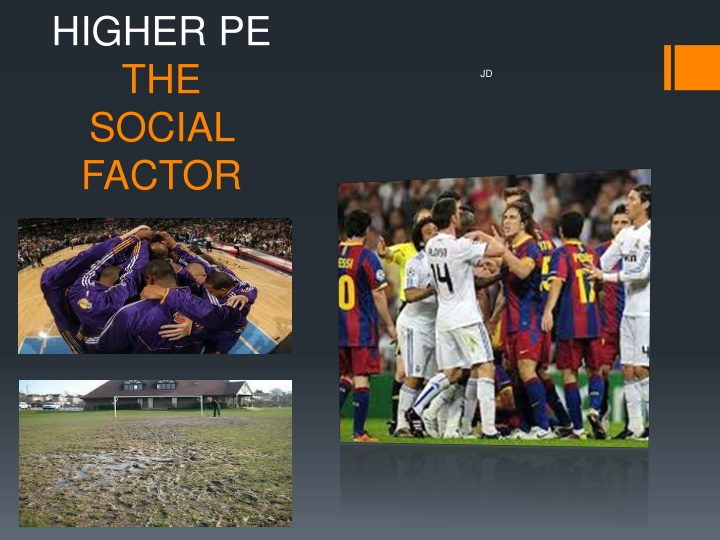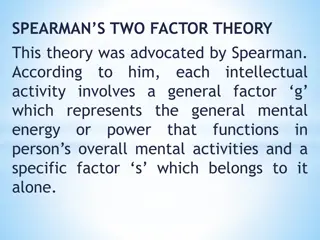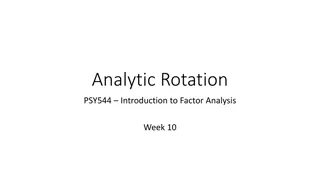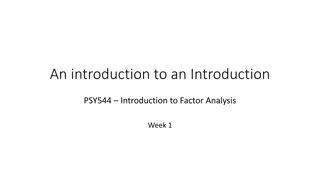
Exploring the Social Factors in Physical Education
Dive into the importance of group dynamics, cultural and societal issues, and environmental factors in physical education. Learn how these elements impact team dynamics, communication, and performance in sports like football, volleyball, and badminton. Understand the significance of inclusion, language, gender, and etiquette in promoting fair play and respect in sports environments.
Download Presentation

Please find below an Image/Link to download the presentation.
The content on the website is provided AS IS for your information and personal use only. It may not be sold, licensed, or shared on other websites without obtaining consent from the author. If you encounter any issues during the download, it is possible that the publisher has removed the file from their server.
You are allowed to download the files provided on this website for personal or commercial use, subject to the condition that they are used lawfully. All files are the property of their respective owners.
The content on the website is provided AS IS for your information and personal use only. It may not be sold, licensed, or shared on other websites without obtaining consent from the author.
E N D
Presentation Transcript
HIGHER PE THE SOCIAL FACTOR JD
Plagiarism Warning Throughout this power point there are sample answers. Please note that these sample answers are not to be used as your own work they are for reference only. If you fail to comply with this request you will be at risk of failing the course.
Higher PE Command Words Describe (Tell us how to do it!) Explain (Tell us why you did it, justify! (+ / -) ) Evaluate (Better than before? Evidence please!) Analyse (Benefits/limitations = result on performance)
The Social Factor There are three main areas within the Social Factor these are: Group Dynamics Cultural / Societal Issues Environmental Issues
What makes a good team? Have a two minute discussion with a partner and create three key features of what makes a good team. http://www.bbc.co.uk/education/clips/z hwgd2p
Group Dynamics (What makes a good team) Co operation Contributing to the team Roles / Responsibilities Team Dynamics (The interactions that influence the attitudes and behaviour of people when they are grouped with others) Ethos / Atmosphere Communication
Group Task / Homework Analyse the impact Group Dynamics may play (+ or -) during a performance in one of the following sports (6) : Football Volleyball Mixed Badminton Doubles Assign each group member a part of group dynamics to cover for your chosen sport, collate your answers together and discuss.
Cultural and Societal Issues http://s215192333.onlinehome.us/uploaded/1/1185197556.jpg
Cultural and Societal Issues Inclusion Language Gender Etiquette & Fair Play Respect for others Conduct of self, players, crowd & officials
Cultural and Societal Issues Motivation A reason or reasons for acting or behaving in a particular way intrinsic motivation empathy self esteem initiative self-discipline offer, give and accept feedback or guidance leadership extrinsic motivation: prestige money media sponsorship fame peer group pressure
Environmental Issues (Barriers to Participation)
Environmental Issues (Barriers to Participation) Facilities Cost Location Weather
Individual Task Analyse the impact of the Social factor during a game of Volleyball. (6) Look at the pictures closely for ideas .
How can we investigate/test? Questionnaire Coach feedback Self appraisal Team mates feedback Environmental Checklist
Questionnaire The questionnaire below could be used to gain information on your group dynamics. Key 1 very poor, 2 poor, 3 average, 4 good, 5 excellent A How good is your team at communicating with each other? 1 2 3 4 5 B How good is your team at encouraging each other? 1 2 3 4 5 C How good is your team at helping, giving feedback? 1 2 3 4 5 D How good is your team at organising practices/drills/training? 1 2 3 4 5 E How good is your team at displaying sportsmanship/etiquette? 1 2 3 4 5 If each person in your team filled this out and the results were collated, your team would gain valuable knowledge about how well you socially interact.
Self Appraisal Criteria What was expected to happen? What worked well? What didn t work well? What have I learned? What will I do to secure success? If possible, with a partner one be the coach and one the performer. Answer the above questions individually and then compare answers regarding a recent performance.
Self Appraisal After one off game After a training period culminating in a performance On your own With a coach, one appraisal each both answering on the performance For this to be at all reliable and effective you need to be: Honest Responsible Ready to receive constructive criticism
Environmental Checklist Environmental Aspect Not at all Sometimes Constantly Weather Wind Rain Sunlight Heat Coldness Frost External Aspects Crowd noise Crowd interaction Officials performance Opponents Non playing team mates Non playing opponents Playing Surface Condition of surface Length of surface Width of surface Self Footwear Clothing Headwear Accessories
Environmental Checklist Post performance / training Carried out by performer Honesty needed for reliability Helps identify small factors outwith your control that has impacted performance Identification of these aids planning for training and next performance Makes performer more aware of environment and allows then to prepare mentally for challenges ahead.
Individual Task (a) Describe two different methods that could be used to collect information about the potential impact of social factors on performance.(4) (b) Select one of the methods described in part (a). Explain why you chose to use this method of investigation.(4)
Team Dynamic Development Approaches Partner/group work team building games (outwith activity) Active listening (wait until person is finished, then think and speak) Restorative practices (mediation, acknowledgement of errors)
Team Dynamic Development Approaches Use of model performers (watch, listen & analyse) https://www.youtube.com/watch?v=vM54ePnpiJ8 https://www.youtube.com/watch?v=Mjgi8ue56ac Defining roles (leadership, positional duties, sets pieces) https://www.youtube.com/watch?v=T3znU7suCx0 https://www.youtube.com/watch?v=6bDU3wkh_dU
Cultural and Societal Issues (you can become involved in) Community initiatives National / local intervention programmes National / local events Rebranding activities
Environmental Issues Development Approaches Warm Weather training Altitude training Preparing for different playing surface Indoor training due to weather
Monitoring Tools Diary Questionnaire Self-appraisal (compare & Contrast) Environmental checklist Team/group feedback Coach/teacher feedback Crowd/audience reaction
Why monitor training? To check it is effective, relevant to development needs, long term targets. Make sure short term targets are met, progress is being made. Provide motivation to further improve. Make adaptations to training if necessary. Ensure strengths are maintained while weaknesses improved.
Social Scenario Games Total Gold Silver Bronze Rank 2002 Manchester 6 8 15 29 10 2006 Melbourne 11 7 11 29 6 2010 Delhi 9 10 7 26 10 2014 Glasgow 19 15 19 53 4 Team Scotland enjoyed their most successful games ever in Glasgow. Analyse how the social factor and one other factor may have played a part in this medal bounce (8)
Revision 1.Name 3 methods you could use to investigate within the social factor? (3) 2.Describe how you carried out one of the methods above for four marks. (4) 3.List two Group Dynamics issues from the social factor. (2) 4.Describe one of the Group Dynamics issues and describe how it could affect your performance in any sport of your choice. (4) 5.Describe a training drill you have done to develop the social factor and how you would progress it. (6)





















